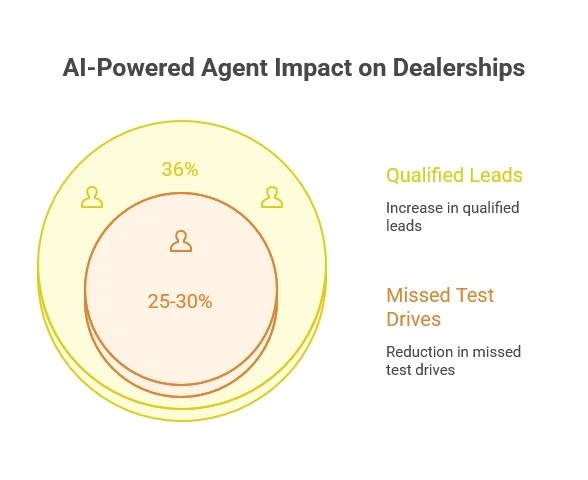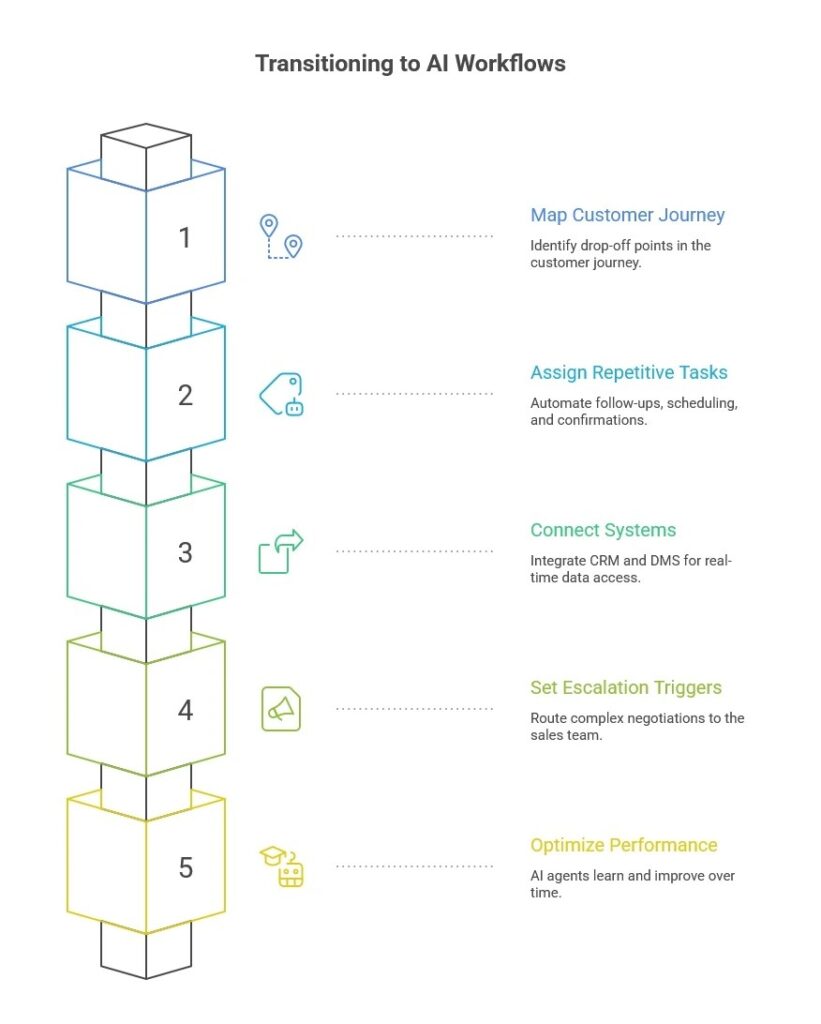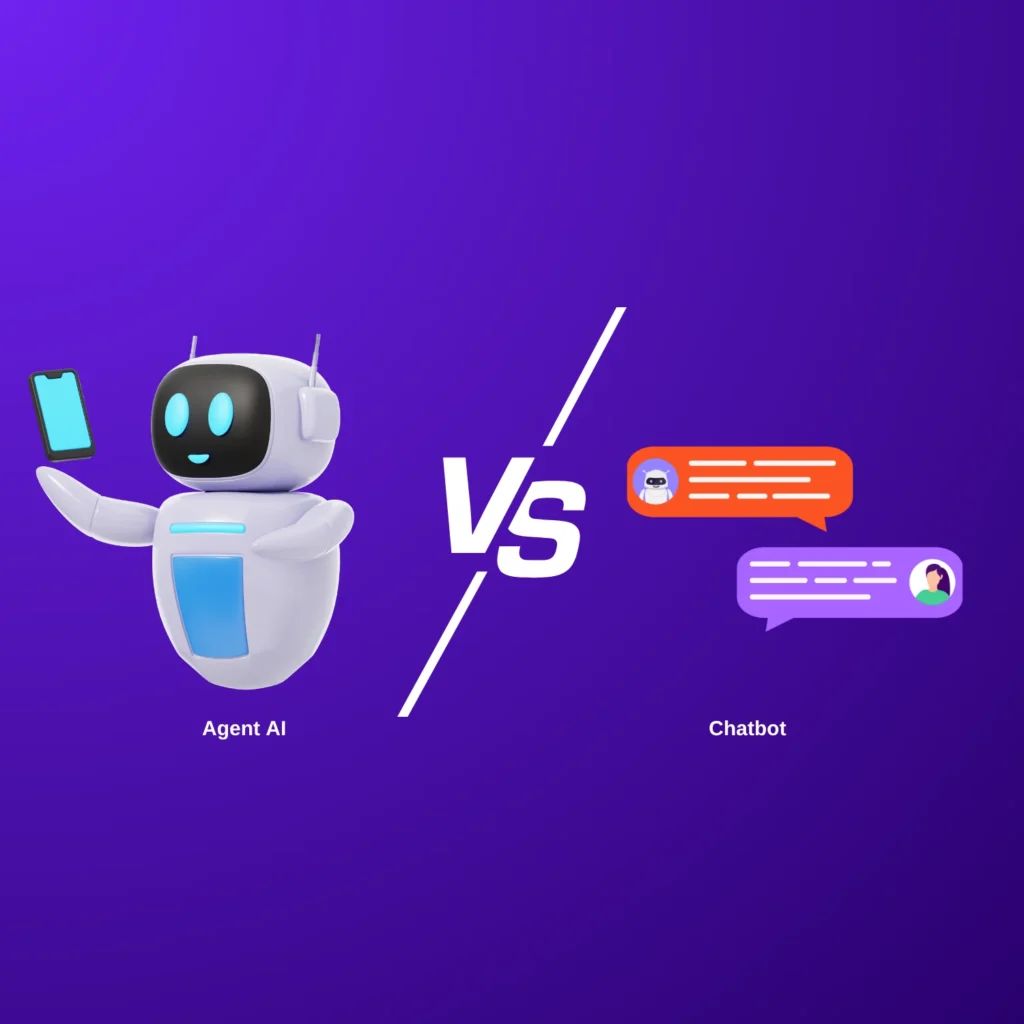The automotive retail landscape is changing faster than any dealership could have predicted. As buyers shift to digital-first research and on-demand communication, car dealerships are under increasing pressure to deliver instant answers, personalized guidance, and 24/7 availability. This shift has sparked one of the most important debates in modern automotive technology: chatbot vs AI agent and which one creates better outcomes for dealerships in 2026.
While chatbots helped dealerships automate basic conversations, today’s customers expect far more. They want intelligent, end-to-end assistance that goes beyond FAQs and lead capture. They want test-drive booking automation, personalized offers, service reminder automation, and seamless conversations across web, WhatsApp, and voice. That’s where AI agents are taking over, not as simple chat tools, but as autonomous systems that perform real dealership tasks.
This guide breaks down everything dealerships need to know about choosing between a chatbot and an AI agent, how each affects customer experience, and why 2026 marks the tipping point for dealership automation.
What Today’s Car Buyer Expects And Why Chatbots Struggle to Keep Up
A buyer browsing your website at 2 a.m. doesn’t want generic replies. If they ask, “Is the Creta SX(O) available in red?” a simple scripted response isn’t enough. They expect real-time inventory checks, personalized finance options, and the ability to book a test drive instantly without waiting for a salesperson to wake up.
For years, chatbots were the default solution for after-hours coverage. They answered basic questions, collected contact details, and prevented dealerships from losing late-night leads. But the rise of agentic AI in automotive has changed expectations entirely.
Customers want:
- Instant test-drive confirmations
- Automated follow-ups across WhatsApp, SMS, and voice
- Contextual recommendations based on their past behavior
- Real-time updates from CRM and DMS systems
- Consistent responses even during peak hours
Chatbots were never designed for this level of dealership workflow automation. AI agents, however, are.
Chatbots in Dealerships: Useful, But Limited in 2026
A traditional automotive chatbot runs on predefined rules or decision trees. It’s dependable for structured queries like:
- Service hours
- Brochure downloads
- Basic pricing information
- Lead forms
- Simple inventory links
These rule-based chatbots still play a role in dealership operations. They’re affordable, easy to deploy, and help manage repetitive top-of-funnel questions. But their limitations become obvious with deeper engagement.
Where chatbots fall short
- They can’t understand vague or incomplete queries.
- They don’t personalize responses based on customer history.
- They don’t follow up automatically.
- They can’t coordinate workflows like scheduling, reminders, or rescheduling.
- They offer basic WhatsApp responses, but not unified conversations across channels.
- They aren’t designed to reduce missed test drives or increase conversions.
If the goal is only answering questions, chatbots work.
If the goal is moving customers toward a sale, they don’t.
AI Agents for Dealerships: The Evolution of Conversational AI Automotive
AI agents represent the next generation of automotive AI, systems that don’t just respond to customers but take actions on behalf of the dealership.
Instead of scripts, they use LLM-driven intent detection, planning engines, CRM/DMS integrations, and multi-channel communication to behave like a digital BDC executive.
Capabilities of dealership AI agents
- Understand natural, unstructured customer queries
- Check real-time stock availability
- Execute test-drive booking automation
- Send follow-ups, reminders, and re-engagement messages
- Recover no-shows by auto-rescheduling the appointment
- Update CRM entries autonomously
- Engage across web, WhatsApp, and voice consistently
- Provide personalized offers based on buyer behavior
This is why AI agents in automotive are rapidly replacing chatbots in 2026. They solve the biggest gaps in dealership automation: speed, consistency, follow-up, and conversion.
Chatbot vs AI Agent: The Real Difference for Dealerships
To understand why AI agents are becoming the industry standard, let’s break down how each behaves in real dealership scenarios:
1. Handling lead follow-up
- Chatbot: Does nothing after initial conversation.
- AI Agent: Sends timed WhatsApp follow-ups, voice reminders, and SMS nudges until the lead converts or opts out.
2. Test drive confirmations
- Chatbot: Shares a form or link; human agent must manually confirm.
- AI Agent: Books directly into the scheduler, updates CRM, and sends reminders.
3. After-sales and service
- Chatbot: Limited to informational responses.
- AI Agent: Runs renewal campaigns, schedules services, and triggers service reminder automation.
4. Multi-channel conversation continuity
- Chatbot: No cross-channel memory.
- AI Agent: Remembers intent, behavior, and conversation history across channels.
5. Revenue impact
- Chatbot: Improves engagement.
- AI Agent: Improves conversions.
6. Customer experience
- Chatbot: Good for basic FAQs.
- AI Agent: Exceptional for automotive buyers expecting contextual assistance.
This difference; conversations vs conversions defines the entire chatbot vs AI agent debate.
Real Impact: How AI Agents Improve Dealership KPIs

Dealerships adopting AI-powered agents like DaveAI’s Autobot or similar agentic systems are reporting measurable improvements within 90 days:
- 36% increase in qualified leads
- 25–30% reduction in missed test drives
- Higher conversion rates from re-engagement workflows
- Better showroom traffic due to automated nurturing
- Reduced operational load on sales teams
Because AI agents don’t rely on scripts, they adapt to every query, creating the kind of fluid, intelligent experience buyers expect in 2026.
When Should Dealerships Still Use Chatbots?
Chatbots still have their place, especially for dealerships that:
- Have low lead volume
- Only require basic after-hours coverage
- Don’t want integrations with CRM or DMS
- Have limited budgets for automation
A chatbot can still improve lead capture by 15–20% for small, single-location dealerships. But as soon as a dealership has multiple channels, high inquiry volumes, or complex workflows, the limitations become costly.
When AI Agents Become Essential (2026 Dealership Reality)
AI agents outperform chatbots when dealerships need:
1. Multi-channel sales automation
Buyers often jump between web, WhatsApp, and voice. AI agents continue the thread automatically.
2. Lead follow-up automation
No more missed opportunities. AI agents handle reminders, nudges, and re-engagement without human intervention.
3. Test drive workflows
From booking to confirmation to reminders, the entire process is automated.
4. After-sales journeys
Service reminders, insurance renewals, feedback loops all automated.
5. Personalized communication
AI agents use CRM data to tailor messages based on model interest, past visits, and engagement patterns.
In short:
Chatbots help dealerships communicate.
AI agents help dealerships convert.
How Dealerships Are Transitioning to Agentic AI Workflows
The shift from chatbots to AI agents isn’t just a technological upgrade; it’s a workflow transformation.
Step 1: Map your customer journey
Understand where customers drop off, usually during follow-up and scheduling.
Step 2: Assign repetitive tasks to the AI agent
Follow-ups, scheduling, reminders, inventory responses, and test-drive confirmations.
Step 3: Connect CRM and DMS systems
AI agents rely on real-time data to personalize recommendations.
Step 4: Set escalation triggers
Complex price negotiations or escalations get routed to your sales team.
Step 5: Optimize performance
AI agents improve automatically as they learn dealership patterns.
Dealerships that once ran a chatbot-plus-human hybrid are now moving to AI-first models that drastically cut manual workload and improve customer experience.

Future of Dealership Automation: What 2026 and Beyond Looks Like
The rise of agentic AI is just the beginning. The next phase of automotive AI includes:
1. Voice-driven AI assistants inside showrooms
2. Supporting walk-in customers like digital product experts.
3. Predictive lead scoring
4. AI agents identifying high-intent buyers before the sales team even calls.
5. AI-powered video agents offering 3D walk-arounds
6. Personalized vehicle presentations created dynamically.
7. Multi-agent orchestration
8. A sales agent, service agent, finance agent, and reminder agent, each handling specialized workflows but sharing the same brain.
The industry is moving from chatbot-driven conversations to AI-driven completions.
And dealerships that adopt early will have a massive competitive advantage.
Conclusion
In the battle of chatbot vs AI agent, the winner in 2026 is clear.
Chatbots were an important stepping stone for dealership digital transformation. They automated the first layer of customer engagement. But today’s buyers expect far more than scripted responses, they want real-time inventory answers, automated follow-ups, accurate scheduling, and multi-channel continuity.
AI agents deliver all of that and more.
They’re not just conversational tools. They are operational engines that automate dealership workflows, boost conversions, reduce missed test drives, and create experiences that feel personal, intelligent, and consistent.
If chatbots helped dealerships talk, AI agents help dealerships sell.



